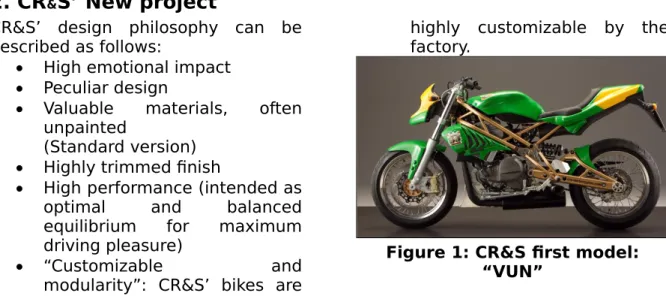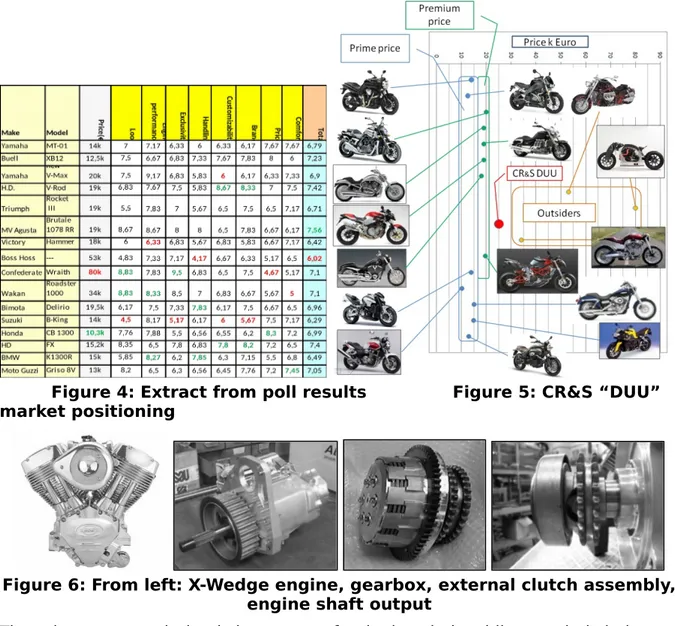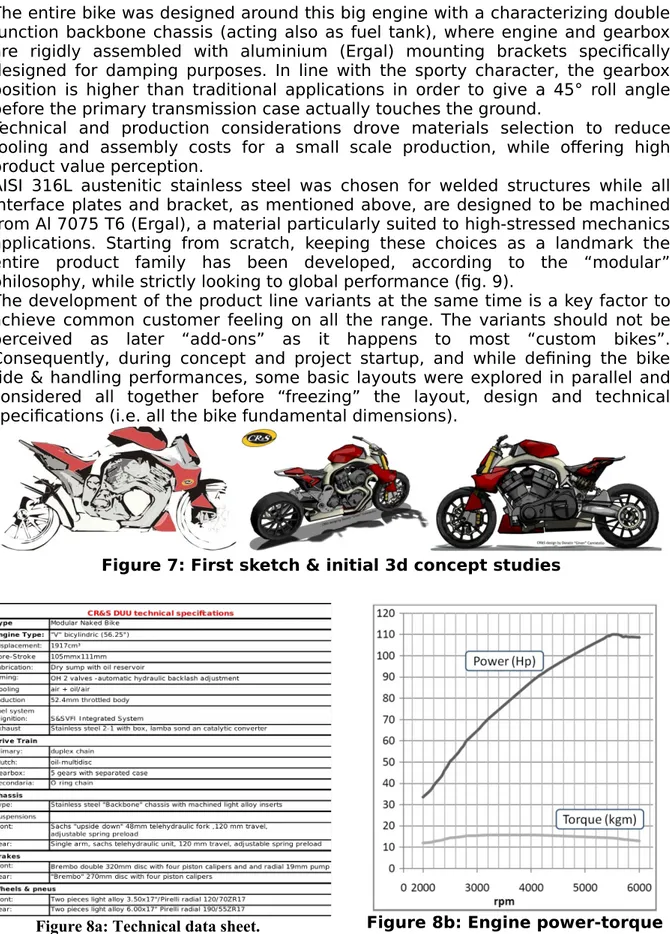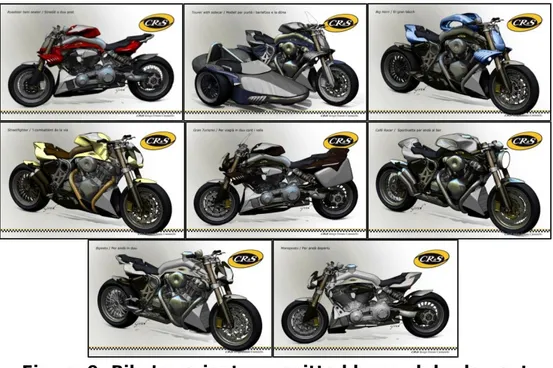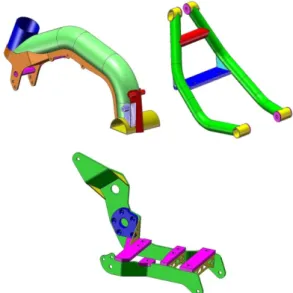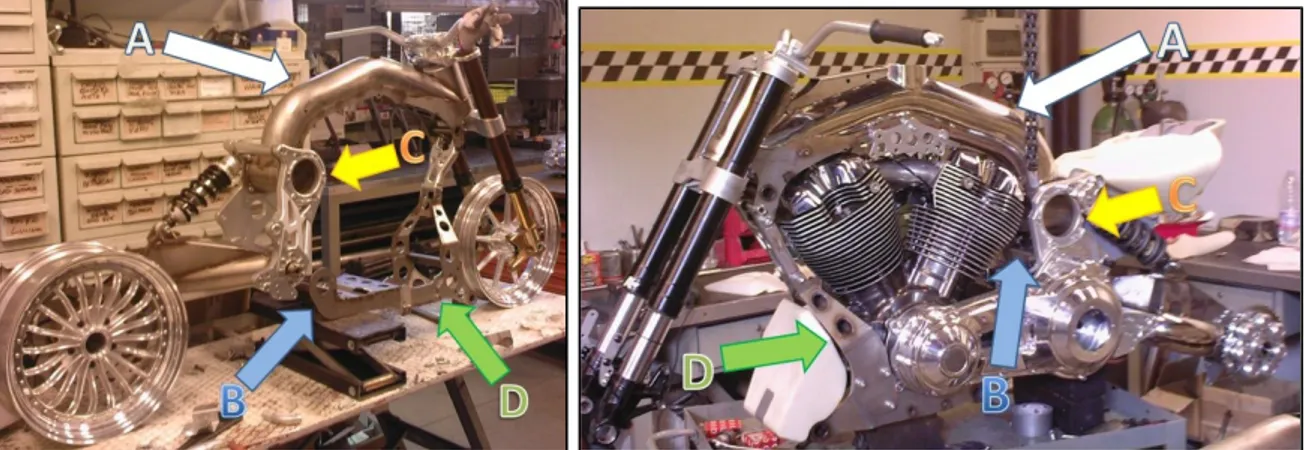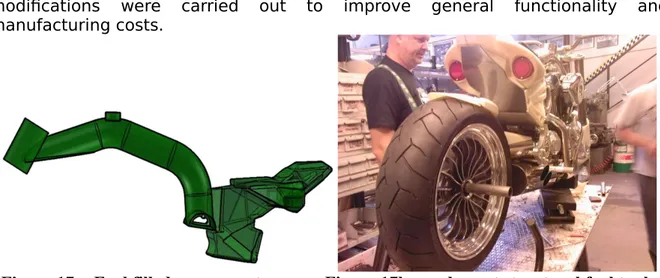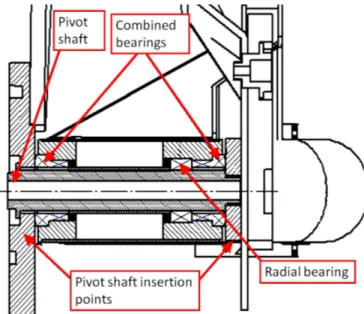INTERNATIONAL DESIGN CONFERENCE - DESIGN 2010 Dubrovnik - Croatia, May 17 - 20, 2010.
DESIGN OF A NEW HIGH-END STREET BIKE
Stefano Uberti, Marco Gadola
Keywords: Motorcycle, handling, chassis, design
1. Introduction
This paper deals with an “atypical” bike design. It can be considered atypical due to the materials used and the peculiar engine – chassis combination. The project was born as a consequence of CR&S desire to access the so-called “maxi-naked” motorcycle market.
The project, called “DUU”, is about a new bike with an adequate family feeling with the “VUN” (the factory’s first commercial model), totally “customizable”; it will be a large capacity, naked sporty two-seater, with innovative design and a very good handling.
In the paper the entire design process leading to the presentation will be briefly explained: market analysis, benchmarking, concept, dynamic behaviour studies, structural calculations, and prototype manufacturing.
2. CR
&S’ New project
CR&S’ design philosophy can be described as follows:
High emotional impact Peculiar design
Valuable materials, often unpainted
(Standard version) Highly trimmed finish
High performance (intended as
optimal and balanced
equilibrium for maximum driving pleasure)
“Customizable and
modularity”: CR&S’ bikes are
highly customizable by the factory.
Figure 1: CR&S first model: “VUN”
Learning from experience in production and selling of the “VUN” model, CR&S developed its own product marketing knowledge, summarized as follows.
Among single-cylinder street bikes, the “VUN” created its own market niche. In the larger “naked bike” segment, CR&S would like to place itself on the top of the maxi-naked sub-sector, using a new formula: “Sport custom”. The “maxi-naked” segment is worth more than 100k bikes/year worldwide.
As a matter of fact DUU’s market positioning will be in a wider market area and at premium price level: 35% higher than the competitors’ average and 25% higher than other prestigious brands, but much lower than the most exclusive outsiders (fig. 5).
The DUU selling potential can be evaluated by taking the VUN selling numbers as a reference: about 0.30% within its market segment, that is to say 300 bikes/year. The company break-even is set at 100 bikes/year and this can be considered as highly feasible. Moreover the product range development program (3/4 versions), already undergoing development, should make selling targets easily under reach.
Base price will be 21.000 € (+ VAT) and production cost (part list + labor + amortization) will be 13.500 €; sales are predicted to be 100% through dealers with a 15% passive commission for the manufacturer. Due to its own positioning the DUU reference market is among the “naked”+“sport-naked”+“custom”+“classic” bikes, which actually is the widest and reaches up to 50% in the Italian market, which in turn is the European reference market. (Fig 2 : from “Moto Dealer News” may 2008)
Figure 2: Maxi-naked bike market
Figure 3: CR&S “VUN”
Following the CR&S brand positioning and focus on innovation, the “DUU” should be a “maxi-naked-sport-custom”, creating its own market niche as it happened with the “VUN”. A minimum market share of 0.1% could also be considered attainable, considering that the “VUN” reaches a respectable 0,3% in a 10k bikes/year market. Subsequently a prediction of 100 to 300 unit total production in five years is realistic. The project long term, strategic effects should be: company development, market share growth, and brand exposure as a high quality manufacturer. Finally the project should turn the company from a small manufacturer of hand-crafted products with a 2.5 million euro turnover to a larger, 5 million euro turnover company, with staff growing to 18/20 people, and with enough resources to self finance its own R&D department for the introduction of a third product line.
A focused survey was conducted to evaluate the potential customer attitude towards DUU’s potential competitors. Such research was based on two questionnaires proposed to a 100 “R.U.B” sample (where “RUB” stands for Rich Urban Biker, or rather well-off people deeply keen on motorcycling: the typical CR&S’ costumer), in order to focus on their preferences and judgment on competitors’ bikes. An extract from this survey will follow (fig 4).
According to market studies, in the maxi-naked segment the engine is the bike’s heart, more than in other bike segments. This is why an S&S factory engine was chosen: its brand new “X-Wedge”, 56° V-twin unit. It features a traditional air cooling, a dry sump and a 1920 cc displacement. Power output is 110 Hp@5500 rpm coupled with a flat torque curve peaking at around 150 Nm. Despite its classic look it is a modern unit that has been developed to cope with severe American noise and emission rules (EPA). It is therefore Euro 3 compliant (EU standard 98/69 CE). The gearbox is also an “S&S” 6-speed unit with its own case and coaxial input and output shafts.
Figure 4: Extract from poll results Figure 5: CR&S “DUU” market positioning
Figure 6: From left: X-Wedge engine, gearbox, external clutch assembly, engine shaft output
The primary transmission is by means of a duplex chain while a sealed chain was chosen for the final transmission in place of a shaft transmission because of rear swingarm geometry reasons. Final transmission ratio was chosen for a 140 km/h cruise speed.
The entire bike was designed around this big engine with a characterizing double function backbone chassis (acting also as fuel tank), where engine and gearbox are rigidly assembled with aluminium (Ergal) mounting brackets specifically designed for damping purposes. In line with the sporty character, the gearbox position is higher than traditional applications in order to give a 45° roll angle before the primary transmission case actually touches the ground.
Technical and production considerations drove materials selection to reduce tooling and assembly costs for a small scale production, while offering high product value perception.
AISI 316L austenitic stainless steel was chosen for welded structures while all interface plates and bracket, as mentioned above, are designed to be machined from Al 7075 T6 (Ergal), a material particularly suited to high-stressed mechanics applications. Starting from scratch, keeping these choices as a landmark the entire product family has been developed, according to the “modular” philosophy, while strictly looking to global performance (fig. 9).
The development of the product line variants at the same time is a key factor to achieve common customer feeling on all the range. The variants should not be perceived as later “add-ons” as it happens to most “custom bikes”. Consequently, during concept and project startup, and while defining the bike ride & handling performances, some basic layouts were explored in parallel and considered all together before “freezing” the layout, design and technical specifications (i.e. all the bike fundamental dimensions).
Figure 7: First sketch & initial 3d concept studies
Figure 8a: Technical data sheet. Figure 8b: Engine power-torque curves
Figure 9: Bike’s variants permitted by modular lay-out
4. Predicted Handling
It is important to explain some basic considerations on bike handling, as a function of the main design parameters. As aforesaid the DUU is a very atypical bike, with an American “muscle bike” engine fitted in a european-style chassis, and oriented to maximum driving pleasure during fast trips or cruising on winding roads. It is therefore necessary to examine the bike dimensions and settings during the design phase very accurately.
In figure 10a and 10b the most relevant dimensions are listed, here only with symbols for confidentiality purposes. Aim of the analysis was to achieve a proper balance between stability and reactivity, operating mostly on the following parameters:
Engine position: this engine is fairly heavy (120kg) and has a large flywheel momentum (with a stabilizing gyroscopic effect), so it is very important to work properly on “h” (bike’s COG height) and “b” (rear wheel trail from COG) parameters by positioning the centre of gravity slightly towards the front
Front wheel trail (“a” in figure 10) and normal wheel trail ,where )
, , (d Rf f
a and an acos R sind (from[1])
(1) Wheelbase (p)
Figure 10 a: DUU’s fundamental dimensions (CR&S)
Figure 10 b: Motorcycle fundamental dimensions affecting ride & handling (from [2])
Consequently it is important to talk about the following ratio: the so-called “wheel trail ratio” (expressed in %): 100
b a
R n
n .
In the “DUU” development prototypes this ratio is adjustable between 5.4 and 7%.
Chain pulling ratio: defines rear swingarm forces equilibrium during acceleration
tan tan ) sin( sin cos r c trasf n R r L T L N R (from [1]) (3)(rc is rear sprocket radius, Me is rear shocker torque and L is swingarm length). If
Rn is slightly larger than 0,5 as in the “DUU” an “anti-squat” effect is achieved.
The rear suspension geometry was designed with a built-in progressive behaviour, with benefits on ride and road-holding; furthermore this limits steering geometry variations due to rear excessive compression (e.g. for low frequency bumps, or with passenger and luggage).
5. The frame
The peculiar bike style and the performances combined with its weight (ca. 240 kg) made frame design a tough challenge. Most of the problems were solved with an unusual approach. As stated above the frame is a mixed structure: a stainless steel backbone is assembled with 7075 T6 alloy machined plates and a fabricated sub-frame by means of bolts.
Figure 12. Frame’s initial lay-out Figure 13. Three sub-frames
The frame design has been carefully developed by means of FEM structural computation. The upper part is the most characterizing in terms of bike design (fig12, fig 16 part “A”). As a matter of fact it is a large diameter, cold formed tube (104mm). It also acts as fuel tank and links the steering head with the rear swingarm pivot by means of the lower part (fig 16, “D” and “B”). It also features the pickup point for the rear shock absorber.
Two machined alloy plates connect engine heads to the upper backbone structure (fig. 16 part “C”). The lower sub-frame is a mixed stainless steel fabricated structure with Ergal plates that connect rear swingarm pivot and related bushings. Furthermore mounting points are provided for gearbox and lower engine crankcase (as shown in fig.16 on parts “D” and “B”).
Front engine cradle initial design was a double tube bridge structure between upper and lower frame to close the structure and spread forces (fig 13, fig 14a). As shown in fig. 14a and 14b , the front engine cradle and lower sub-frame manufacturing process was quite complicated. Therefore their design evolved into a stainless steel sheet metal structure, laser cut, folded and welded like an “origami”, this providing benefits also in terms of look overall (fig.15a,b).
Figure 14a: Front engine cradle
Figure 15a: Lower frame
Figure 14b: jig for building and welding.
Figure 15b :jig for building and welding.
Figure 16: DUU’s final frame: A =backbone, B= lower frame, C= machined plates,
D=front engine cradle.
The frame can be seen as tailored on the engine to achieve a compact bike design, despite the large engine dimensions (fig.16). The machined plates act primarily as interface in order to embrace the engine.
Moreover these plates, due to Ergal mechanical properties, are aimed at controlling vibrations. During the prototype building phase some additional
modifications were carried out to improve general functionality and manufacturing costs.
Figure 17a: Fuel filled components
Figure 17b: underseat structural fuel tank.
Fuel primary tank, as aforesaid, is the backbone tube itself. The capacity -around 7 litres- is not enough for the desired 200 km mileage. For this reason an innovative decision was deemed necessary: the rider and passenger sub-frame was replaced with an aluminium sheet structural monocoque fuel tank, taking total fuel capacity to 16-18 litres. This additional tank is fitted to the main frame by means of rubber bushings, in order to reduce vibrations and improve ride comfort. This tank -clearly visible in figures 17a,b- is currently undergoing development. The tanks are connected via appropriate fuel lines in order to optimize refuelling.The engine being a dry sump unit needs a separate oil tank. It is placed on the right side between engine and gearbox in order to lower the CoG. An oil heat exchanger is also provided to improve engine cooling. It is positioned in front of the engine cradle, exposed to the air flow(fig.18a).
A single arm structure was chosen for the rear suspension as a trade-off between design and functional requirements. It should be noticed that this lay-out is always subject to torque loads around the longitudinal axis and requires a proper design for torsion stiffness.
The effect of torsion are present even in straight running, and it is directly proportional to rear wheel loads. Any swingarm twist results in wheel misalignment from the bike vertical plane, thus generating tyre side forces and affecting driving behaviour.
Figure18a: Oil heat exchanger housing
Figure18b: structural fuel tank fairing.
The wheel spindle is fitted by means of an automotive type upright structure. The rear rim large offset provides room for the brake caliper and diskIn line with the peculiar backbone structure design, the swingarm is also made of a large diameter cold formed tube (AISI 316L) with a laser cut, sheet metal stiffening rib supporting the primary structure and accommodating the rear shock pickup point.(fig 19a)
As mentioned above, the rear suspension geometry features light anti-squat effects (Rn>1) during acceleration (contrasting suspension compression) and anti
dive during braking (contrasting suspension extension).
Swingarm pivot hinge is realized by means of needle-combined bearings to feed vertical and transverse loads into the frame, thus reducing slip-stick effects with positive influence on ride quality (fig 19b).
Wheel bearings are contained in an adjustable eccentric cartridge clamped to the swingarm (fig.19b).
Figure 19a: rear swingarm
Figure 19b: front mounting scheme.
6. FEM analysis
In order to validate the frame strength and stiffness calculation, FEM techniques were applied to both frame and swingarm design in their final configuration. They underwent a number of simulations with different load cases corresponding to heavy braking, acceleration, cornering, riding over severe bumps, as well as their combinations. Effective stress levels were confirmed to be within a range of 35 and 110 Mpa, thus giving a 2-3.5 safety factor on AISI 316L (σrp0.2 = 235MPa).
Figure 20: Rear swingarm first and second vibration modes.
Swingarm natural frequencies and vibration modes can also affect handling. It is therefore important to analyze and predict possible interactions with powertrain
and road profile energy input. Maximum wheel speed is 1795 rpm corresponding to 29.9 Hz, while the tyre own chatter frequency is about 20 Hz. FEM models showed that the first swingarm natural frequency is placed well beyond the above typical inputs.
Conclusions
Up to this development stage, the “DUU” appears to be fully adequate to its market target. Its peculiar design characteristics are dedicated to driving pleasure understood in the European way. First road tests on prototype are currently in progress and are confirming the design goals.
The DUU was presented to public and press during EICMA 09 in Milan, one of the world’s leading bike shows, achieving a very good success: the first year production was already sold three weeks after the show.
In spring -summer 2010 some important checks on project will be done: a massive road test conducted by professional testers and a fatigue test on a road simulation bench.
From the first we expect to verify how correct initial design was. From the latter we expect to verify deeply, with augmented stress on structure, calculations on frame and others components.
By means of these two phases outputs we will act on design to modify bike’s behaviour.
After CR&S first two bikes experience, some reflections can be done on what can be improved to stay ahead of competition. Firstly it is very important to create a remarkable brand identity, focusing on some key elements in product line. CR&S focused on sporting-bikes with top quality components suited to be totally factory-customizable. Then another key factor has been in exploring new market areas, where big producers cannot or do not want to investigate, these sectors being too small to guarantee revenues for consistent investments.
CR&S strategy is to identify such areas and enter them from top with a high valuable product, to be clearly associated with this market sector. So strategy towards competition is to anticipate it, being ready with an improved product when concurrence will enter the same market sector.
For the near future, we are collecting feedbacks from bike shows in which the DUU is exposed, trying to analyze them to update the bike to meet customer’s expectations.
Our future market challenges will be in using revenues from DUU’s selling in expanding CR&S with a third product line while creating a structured R&D department and perhaps a racing division, whose aim would be to enforce brand’s reputation among European sportsmen.
References
[1] Gaetano Cocco with Aprilia, “EFFETTO MOTO” -Dinamica e tecnica della
[2] Vittore Cossalter, “MOTORCYCLE DYNAMICS”, Lulu Editions, 2002.
[3] Tony Foale, “MOTORCYCLE HANDLING AND CHASSIS DESIGN” – the art and
science, Giorgio Nada Editore, 2002.
[4] Neil Spalding, “MOTOGP TECHNOLOGY”, David Bull Publishing, 2006
Dr Stefano Uberti Researcher
Università di brescia, Dipartimento di ingegneria meccanica e industriale. Address, City, Country
+39 030 3715517 / +39 030 3702448 [email protected]
http://www.crs-motorcycles.com/ http://archimedes.ing.unibs.it/
